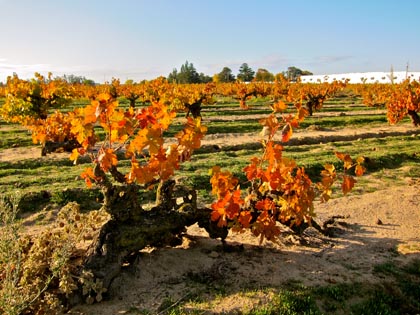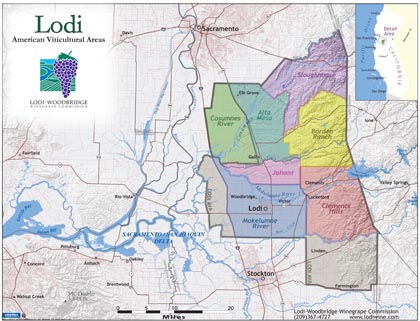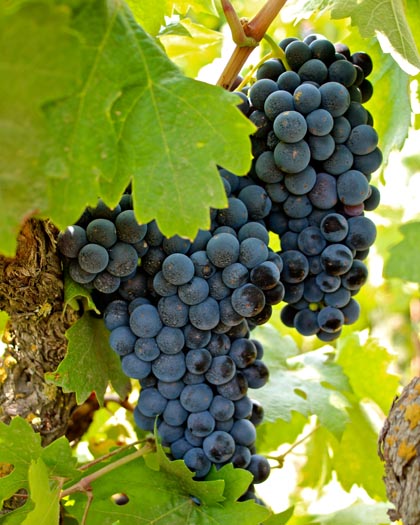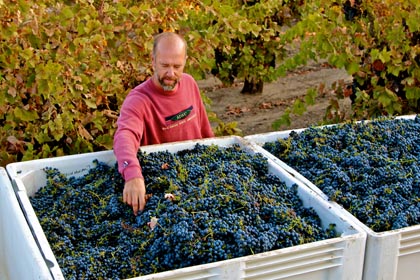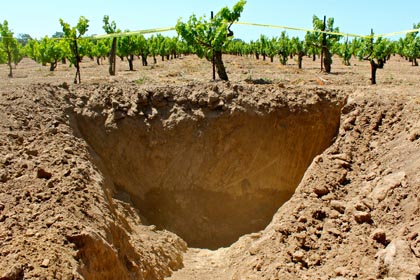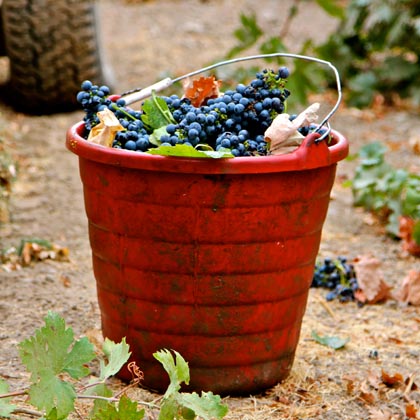Letters from Lodi
An insightful and objective look at viticulture and winemaking from the Lodi
Appellation and the growers and vintners behind these crafts. Told from the
perspective of multi-award winning wine journalist, Randy Caparoso.
East side, west side, Lodi Zinfandels getting around the block
Beach blanket Zinfandel: November in Noma Ranch’s dry farmed planting on the east side of Lodi where the soils are the sandiest and deepest
Part 2 of our autumn paen to Zinfandel (starting with Lodi Zinfandel's transitioning styles and food moxie):
In 1991, some 600 of Lodi’s grape growers came together to form the Lodi-Woodbridge Winegrape Commission (since shortened to Lodi Winegrape Commission). At that point in time, according to the Commission’s former Executive Director, Mark Chandler, “The trade and consumers viewed Lodi as a jug wine region, despite the fact that even then we were the largest producer of premium quality wine grapes in the state, which we still are.”
Today wine bottles bearing the Lodi appellation are seen on retail shelves and fine dining restaurant wine lists across the nation, and it is no longer a surprise when Lodi wines win double-golds and even “Best of Show” accolades in tasting competitions involving thousands of wines from other American wine regions.
A lot of this newfound respect has been associated with one of California’s heritage wines: Zinfandel. In fact, over 40% of California’s Zinfandels are crushed in Lodi, almost all of it grown in the sub-appellation considered the region’s historic heart and soul: the Mokelumne River American Viticultural Area, one of seven Lodi sub-AVAs officially established in 2006.
Quantity, of course, never equals quality. Yet much of the recent surge of Lodi consciousness among connoisseurs has been driven by the intrinsic quality of the region’s grapes; and from within the region itself, a mini-explosion of growers-turned-winemakers, diverting increasing amounts of their crop from the old jug wine pipelines and into ultra-premium bottlings.
Soucie Vineyard Zinfandel, originally planted in 1916
When it comes to the finest wines in the world, top quality always comes down to the concept of terroir, or growing conditions defining "sense of place." Here are the reasons why the cream of Lodi’s Mokelumne River Zinfandel crop has made such an impact since the turn of the twenty-first century:
Moderate Climate
The intrinsic intensity of Lodi’s Mokelumne River wines are very much a reflection of the AVA’s low elevation (mostly 10 to 85 feet) terroir – defined by its Mediterranean climate, which is strongly influenced by direct proximity to the Sacramento-San Joaquin River Delta, channeling cool air from San Francisco Bay even during the dog days of summer. Mokelumne River is the coolest of Lodi’s AVAs. Recent readings put its U.C. Davis climate classification, or Winkler scale (a measurement of average temperatures over 50° F. during the growing season), towards the lower end of Region IV and in many years veering into Region III, which makes it slightly cooler than the Napa Valley floor between St. Helena and Calistoga, and closer to Napa Valley’s famous Oakville and Rutherford AVAs in heat summation.
Ideal Soil and Matching Grape Sites
Unlike Oakville and Rutherford, of course, Mokelumne River is less about Cabernet Sauvignon (although softer, attractive styles of Cabernet Sauvignon are grown in Lodi) than Zinfandel, which thrives in the region’s deep (as much as 50-100 feet), fertile yet extremely well drained, sandy alluvial soil (classified as Tokay Sandy Loam). Prior to the advent of modern day irrigation systems, higher water tables, ample rain and soil moisture retention allowed for successful dry farming (amended by traditional furrow irrigation) in the Mokelumne River area; sustaining thousands of acres of old vines thriving in a balanced, natural ecosystem throughout most of the past 150 years.
Age Before Beauty
At least a quarter of Mokelumne River’s plantings went into ground over forty years ago; some of the most significant sites dating back to the 1880s (such as those in Jessie’s Grove’s estate), 1901 (Mohr-Fry Ranches’ Marian’s block), 1916 (Soucie Vineyard), plus numerous other highly productive vineyards planted between the 1920s and the early sixties. These are, of course, largely gnarly, free standing, head or vertical cordon trained (the latter, with layered spur positions) Zinfandel vines, yielding as little as 1 or 2 tons per acre, yet some as much as 4 tons. And everyone knows what lower yielding, deep rooted old vines can produce: the types of red wines many wine lovers love most – with deep pigmentations, nostril tingling aromas, and ultra-rich yet finely balanced flavors, even at higher alcohol (14% to 16%) levels.
Todd Maley with his 2012 Maley Bros. Zinfandel harvest on Lodi’s west side
Ungrafted Vines
When they say old vine in Mokelumne River, they do not mean any ol’ old vines. Most connoisseurs outside the region are unaware of the fact that these porous, sandy soils have always been inhospitable to the infamous phylloxera blight that wreaked havoc elsewhere around the world at the end of the nineteenth century. This explains why over 5,000 of Mokelumne River’s 42,000 planted acres still sit on their own rootstocks – one of the largest collections of ungrafted Vitis vinifera remaining in the world. Does this make for "better" Zinfandel? Whether demonstrable or not, natural roots are known to be less vigorous than rootstock selections largely preferred by the American winegrowing industry for grafting. In Lodi, in fact, the highest quality Zinfandels have long been known to come from vineyards that are own-rooted, whereas blocks on grafted roots are less preferred (although there are a few sites that have performed favorably on St. George rootstock over the past 100 years).
East vs. West Side Zinfandels
During the past twelve years, the increasing number of single-vineyard bottlings (i.e. labels with vineyard designations) has begun to reveal subtle yet significant difference between Mokelumne River Zinfandels grown east of Hwy. 99, and Mokelumne River Zinfandels grown west of the City of Lodi (between Lower Sacramento Rd. and Interstate 5).
Although the Tokay sandy loam and Delta climate are pretty much the same throughout the Mokelumne River area, old-timers as well as the latest generation of winegrowers generally agree that soils on the east side tend to be a tad sandier – often beach-like in porosity – and are usually deeper. With water tables buried closer to 30 feet below surface, deeper rooted Zinfandel plants on Mokelumne River’s east side tend to yield smaller clusters and berries; resulting in wines with slightly higher acids and skin phenolics (that is, stronger tannins and flavors). Three classic examples of east side Lodi Zinfandel include Macchia’s Outrageous from Noma Ranch, Harney Lane’s Lizzy James, and Klinker Brick’s Old Ghost.
Trench dug below Bechthold Vineyard on Lodi’s west side, showing classic Tokay sandy loam that is visibly damp about 15 ft. below surface
While tending towards rounder textures and fuller bodies, the voluptuous fruit qualities of Lodi’s west side Zinfandels are no less attractive. Three classic west side Lodi Zinfandels include those of Maley Bros.'s Wegat Vineyard, m2’s Soucie Vineyard, and McCay’s Truluck’s. Although winemaking styles often blur distinctions, in the coming years consumer awareness of east vs. west side Lodi Zinfandels is bound to grow – and with that, critical acclaim for individual Lodi terroirs, drilled down to special blocks within single vineyards.
Fruits of Their Labors
A good majority of Lodi’s 750 or so independent growers come from third, fourth, fifth and (increasingly) sixth generation families who have been living and working together – and of course, socializing and intermarrying – since 1858, when the first San Joaquin Valley winery (called El Pinal) and vineyards were established. By the 1980s there were still fewer than twenty-five wineries in Lodi.
Today, there are over eighty Lodi based wineries – most them owned by the same families who have been farming in the region all along.
The bulk of the region’s grapes still go directly to giants like E. & J. Gallo and Woodbridge by Robert Mondavi (the late Robert Mondavi, incidentally, first came to Lodi as a pre-teen and graduated from Lodi Union HIgh School), and a surprising amount of grapes are still packed up and sent to home winemakers and wineries on the other side of the country. But it is the growing number of small to medium sized specialty wineries – the “Lodi natives,” if you will – who are doing the most to expand the Lodi's reputation as a premium winegrowing region.
For instance, the Phillips family behind Michael David Winery has been growing grapes as well as fruits and vegetables in the region since the 1860s. In the late nineties the Phillips brothers, Michael and David, were still crushing only about a thousand cases a year. Today, their yearly production is approaching half-a-million cases, and they sell out everything – from their $16 "7 Deadly Zins" to their $59 "Lust" Zinfandels – within a few months of release.
Even at $30 to $60 price points, says Michael David president/co-owner David Phillips, “I think Lodi wines over-deliver on quality per price, and consumers know it.” While racking up sweepstakes awards and accolades like nobody’s business, Michael David has also established footholds in Canada, China, Southeast Asia, and throughout Europe. “We’re really big in Sweden,” quips Phillips… “I guess because the Swedes like to barbecue, and they love a good ol’ American Zinfandel with their barbecue as much as anyone!”
Next week, part 3 of our autumn paen to Zinfandel: Lodi winemakers analyze 12 of their top 2010 Zinfandels
2012 Zinfandel in Mencarini Vineyard, on Lodi’s west side
